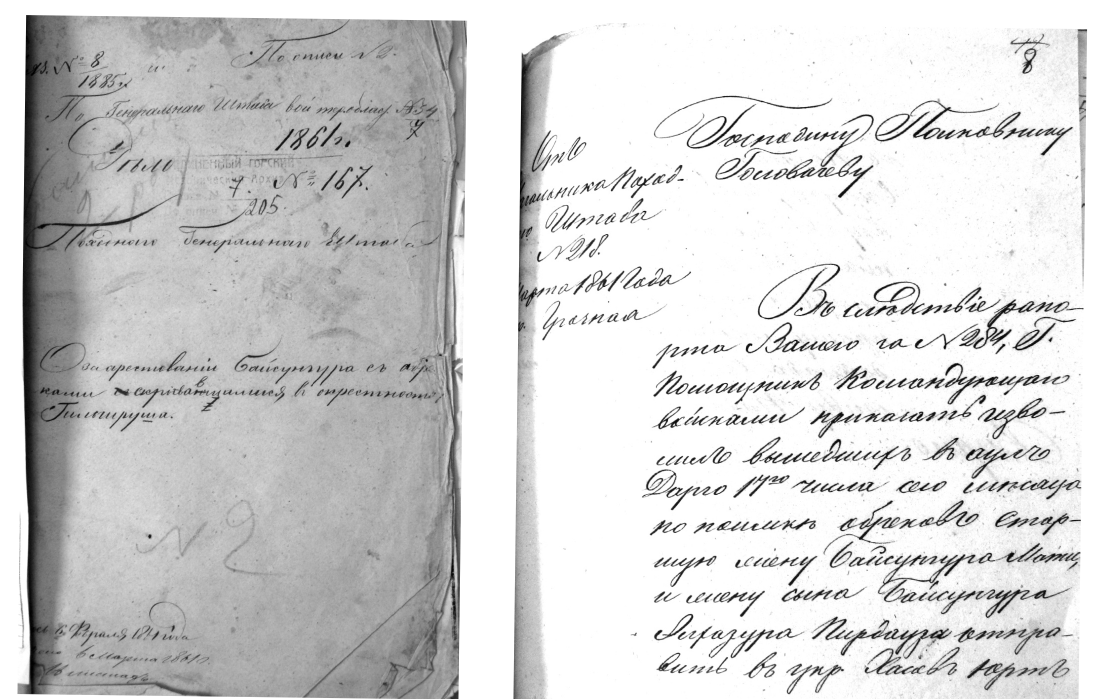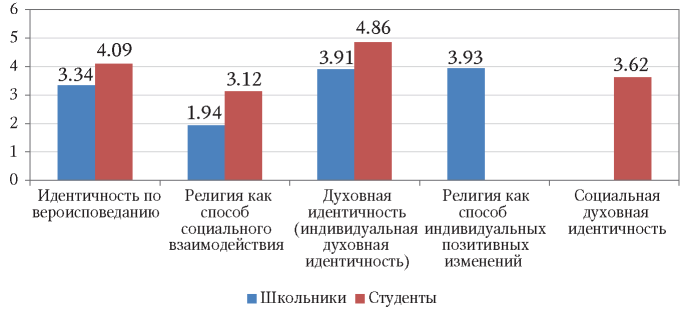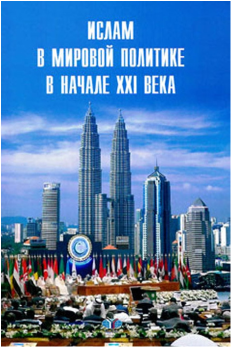SCIENTIFIC LIFE
The Member of the Russian Academy, Vitaly Naumkin, the President of the Institute of Oriental Studies has been honoured with the Russian Federation National Award for outstanding achievements in science and technology (Arab and Islamic Studies).
HISTORY. International relations and Islam
HISTORY. Methods of historical research
The article deals with the phenomenon of communication in religious spheres and its role in the changing and transformation of the category of the “other”. It is about how religion, as a social institution, used the principles of social (artificial) kinship by imitating the principles of biological kinship and thus turned the “alien” people into co-religionists. Singling out the religious communication as an independent issue (along with other types of communication, such as social, political, ethnic, economic, legal, cultural, etc.) is one of the components of the recently introduced system-communication approach to the study of history. Another aspect of this approach is the use of a “cross-cultural method”. Among its working principles this method has a reference to semantically equivalent (or similar) phenomena, which occur in different cultures and traditions.
HISTORY. Russian and Foreign History: Sources
The article deals with one of the most important and at the same time completely events in the biography of Baysungur of Benoy (1794–1861), the Chechen Naib during the Caucasian War of the 19th cent., namely his stay at Ghunib (August 1859) and his personal presence at the capture of Imam Shamil. This episode has recently attracted much attention and became a subject of various speculations both with a scholarly and ideological background. The author based her research on a wide array of hitherto unknown as well as already published documents. The latter, however, have not received enough attention. The unpublished sources originate from the Russian State Military Historical Archive (Moscow), the State Archive of the Kaluga Region, the Central State Archive of the Republic of North Ossetia-Alania, etc. This cornucopea of rich historical data allows her to reconstruct in detail the very last period of the Imam Shamil State and to successfully put it within the framework of the and political situation in the Caucasus in 1859. A detailed analysis of numerous local sources, which are written in Arabic and directly originate from the Imam Shamil environment as well as the papers from the headquarters of the Russian Imperial Caucasian Army leads to a convincing conclusion regarding the whereabouts of Naib Baysungur in August 1859. It proves that at that time he was definitively away from Ghunib.
HISTORY. Russian Muslims: Lives and Documents
The article deals with the role of Muslim Tatars, which they played in the educational system of the Azerbaijan SSR. This is the first attempt to present a detailed picture of the wide range of activities as they come from various archival sources, such as opening of secondary schools and preschool institutions of Volga Tatars in Azerbaijan, the principles and routine of arranging teaching in the Tatar language as well as training the Tatar nationals to become teachers. Among the sources used to write this research paper are the materials from the State Archive of the Republic of Azerbaijan, the Archives of Political Parties and Public Movements of the Administration of the President of the Republic of Azerbaijan, as well as some already published documents. The research has shown that the major influx of the Tatar nationals in Azerbaijan did happen in 1921–1922 mainly because of the famine in the Volga region. They refugees were provided with everything necessary: housing, work, the opportunity to learn in their native language. The problems that arose in the course of re-settlement of the Tatars were solved promptly and the whole process of their solving was controlled by the governmental bodies. The Azerbaijan communists considered the process of the Tatar adaptation as an important issue of their policy. The Tatars were continued to be educated within the framework of their national culture. The vehicle of education was the Tatar language. According to the statistical data from that period the literacy level among the Tatars was traditionally very high. To preserve it the Azerbaijani state made various efforts, including the arrangement of supply the Tatar schools with teaching aids in Tatar language. The state was interested in the high level of the public education and supported it.
HISTORY. The History of Relations Between the State and Religious Denominations
This article deals with the study of the views of the Soviet intelligence on the so-called short-lived “Caliphate movement”, which originates from the then British India. Even after its official abolition in 1924, this institution did not lose its symbolic appeal for Muslims across the world. As an idea it continued offering the Muslims a sense of the umma i.e. the global community of Muslims. The author offers the Soviet intelligence interpretation of the idea of the Caliphate movement in the context of the Soviet “eastern” foreign policy. The article describes this issue through the prism of interaction between the Eastern Department of the OGPU (USSR Secret service) and Musa Bigiyev, a prominent Russian Muslim leader of the 19th–20th cent. Based on hitherto unknown archival materials and the most recent Russian and foreign historical studies, the author offers a comparative analysis of the attitudes of various Soviet and Communist Party institutions to the Caliphate idea and the Caliphate movement in the context of anti-colonial, anti-European struggle. In conclusion article shows the discrepancy between the strategy and tactics of Soviet intelligence services as opposed to the views of European (in particular, British) intelligence services. As a result, these activities contributed to the restriction of independence of the Russian Muslim elite on one handside, strengthening the anti-Caliphate feelings and Islamophobic views among the Soviet management elite on the other.
The article deals with the process of implementation of the anti-religious policy by the Tatarstan authorities in the Republic of Tatarstan in 1920s. The research is based on a wide range of materials, such as the 1920s newspapers and periodicals, especially the newspaper “The red Tatarstan”. The author traced the data regarding the ways and mechanisms, which were aimed to discredit the Islamic religion. Alike the Christian Creed, Islam at that time became the target of the open and acute attacks. Despite some temporary concessions with regard to the Islamic education, the authorities did firmly stick to the plan to eradicate the religious values. The atheist views were compulsory spread among the workers and peasants, the atheist propaganda filled the media, the religious centres (mosqueus, etc.) were gradually closed.
HISTORY. Islam in Asian and African Countries
THEOLOGY. Religious Philosophy in Classical Islam
This is a continuation of the publication of the translation into Russian of IbnRushd’s treatise, in which he criticizes the principles of Kalam theology, especially those of Asharites, and juxtaposes them to the Quranic arguments. The present part deals with the first two questions from the fifth section “God’s deeds” – the creation of the world and the sending of the prophets. The author defends the eternalist view on the phenomenon of Creation, which was typical for the falsafa. He also suggests an original concept of two types of miracle as a proof for the authenticity of Prophetic missions.
Classics and Contemporary Representatives of Muslim Theological Thought
The article deals with various legal aspects as recorded in the works by Shihabetdin Marjani, an outstanding Tatar religious philosopher and an encyclopaedic writer. Surprisingly but the legacy of such an outstanding scholar has not yet received a detailed study. Traditionally he is being seen mainly as historian whereas his legacy comprises a significant number of works on Islamic law, its history, various liturgical problems, as well as fasting and interfaith marriages. The author of the article makes an effort to fill this gap He examined the main theological works by Marjani, analyzed his views on ijtihad and taklid, the history of Islamic law, the problems of prayer and fasting, etc.
The article deals with the history of development and basic ideas of Islamic feminist hermeneutics. In order to understand tendencies of development of the modern Islamic thought, it is important as well to study feminist ideas in their complexity. The author argues that feminist hermeneutics in Islam represents a set of approaches towards the interpretation of the Holy Qur’an, the Hadith and secondary sources of Islamic spiritual tradition. In the typological perspective, it is close to the so-called “Standpoint feminism”. The author singles out seven basic features to Islamic feminist hermeneutics, which are the religious frame of mind, following the principles of Islamic ethics, the use of so-called “contextual ijtihad”, accepting the egalitarist values, the critical approach to tradition, the critical approach towards the Hadith, use of the new methodology, which has its roots in the heritage of Neomodernist school of thought.
THEOLOGY. Islamic education
The paper offers an analysis of phenomenon of Islamic education. There is argued that the theoretical and historical analysis of this phenomenon prevails in comparison to the practical field studies. The author analyzed the present state of religious education in the Republic of Tatarstan as well as the problems, which arise in this context. It has been identified the role of religious education in the young Muslims formation. The author also traces the influences of madrasas on their students’ family values as well as employment prospects. The rich field material was collected from the 10 interviews given by the full-time students (shakirds) of 4th and 5th academic years. The answers received made clear the basic differences between the males and females in their view on the life values and career. Young females appear to be more family-centered and plan to use the religious education they have received to facilitate in the future the upbringing and education of children. They set family values above educational and professional goals. However, the life strategies of young males vary to a significant extent. Some have already clear plans to continue their religious education and see their future employment in various spheres of Islamic worship. On the contrary others still do not have clearly shaped plans for future and do not plan to continue religious education. The system of Muslim religious education has some disadvantages in comparison to the secular education. The goals of religious education are not always clearly set, there are no prospects for further education and career, which is often reflected in unwillingness of the students to stick to the professional career in religious sphere.
PSYCHOLOGY. Personality Psychology
The article offers an analysis of the Shiite ritual self-torture (Ashura or Shahsey-Wahsey) as seen in a psycho-emotional way. In the first instance, the author offers an analysis of the Ashura ritual itself, the attitude of the Sunnis towards it, as well as a special kind of performance, which grew out of it. The author also gives an interpretation of the ritual of self-torture as a psychological phenomenon and discusses possible reasons for irrational behavior of its participants and spectators. As a result, it was revealed that the basis of the irrational behavior of both the participants and the spectators of the ritual is the emergence of affective (emotional) empathy. It should also be noted that in course of the analysis of the psychological state of three categories of people (those who are deeply aware of the meaning of ritual acts, those who perform the ritual and the spectators) was discovered a manifestation of the two-level empathy, i.e. 1) the empathy in its literal sense, when its object is placed directly in front of the empath as in the case of witnesses of a ritual procession; 2) the empathy of a different kind, which is called here as the “empathy of a deep religious world perception”. This is a kind of empathy when the object of empathy is located in the depths of the world perception from the religious point of view.
The article offers an overview of a series of philosophical and psychological researches regarding the attitude of a person to his death. The author compares the phenomena of the acceptance and denial of the very fact of a death from the point of view of their efficiency as psychological phenomena. A particular attention is paid to the religious perception and awareness of this phenomenon as well as compared the relationship of the categories of fear of death and religious perception of the world. The main argument is an attempt to outline the decisive aspects of the attitude to death that forms the religious faith of Muslims and the level of efficiency the Islamic creed provides to an individual to cope with the fear of death. The author has made an attempt to identify the factors, which made a fundamental impact on the Muslims’ perception of the world and its order.
PSYCHOLOGY. Ethnic, social and other groups: Social Psychology
The article offers a socio-psychological analysis of religious identity structure of Muslim youths who live in the Russian Federation. The research was conducted in the Chechen Republic (city of Grozny). The two groups of respondents were selected, the high school pupils (9–10th grades) and students (1–2 year). In order to study their religious identity was applied a “Religious identity components” questionnaire. The original version of this tool was developed by D. Van Camp, it was adapted to the Russian circumstances by V. A. Shorokhova and subsequently developed by O. S. Pavlova. The results of the study prove that religious identity of the two age groups in both cases remains the same, i.e. the four-factor model, regardless the respondents’ age. However, there are still some specific features as applied to each group.
INTERDISCIPLINARY RESEARCH
The article deals with the history of Turkish emigration to Germany in the 20th-21st Cent. This is in a way a novelty both in the modern Turkish literature as well as in the studies, which analyze the reflection of this process in modern Turkish literature. For the first time, this topic was raised in the 1940s, in the novel by Sabahattin Ali (1907–1948), who had been studying in pre-war Germany for some time/ Based on his personal impressions and recollections he wrote a love/political novel “Madonna clade in a fur coat” (1943). Subsequently this topic was also raised in the works by Füruzan (born 1932) and the Turkish Nobel Prize winner Orhan Pamuk (born 1952). The present article discusses the phenomenon of transformation of either personal or somebody else’s experience as reflected by a number of Turkish authors. This fact has ultimately shaped the acute problems as discussed in the Turkish literature and was instrumental for the formation of a whole trend in the modern Turkish literature, i.e. the Turkish émigré literature (Emine Sevgi Özdamar, (born 1946)). The aim of the article is to show the trends in the modern Turkish literature, which preceded the making of the literature of the Turkish diaspora abroad.
The article comprises a communication by Dr. Dyya Nafi, the professor at the University of Baghdad, (at present of the city of Vladimir, Russia) given at the XII Conference of Arabists of the Institute of Oriental Studies of the Russian Academy of Sciences (November 27–29, 2017, Moscow) on the first Russian-Arabic dictionary of proverbs and sayings, which was published by the publishing house “Nowar” (Baghdad) in 2017. The communication stresses that the comparative paremiological studies of the Russian and Arab sources were conducted both in Iraq (the Russian Department of the Baghdad University) and in Russia. As an example the speaker did refer to the book “The Comparative Study of Russian and Arab Proverbs” (Baghdad, 1978) as well as the Russian-Arabic Phraseological Dictionary (Moscow, 1989). In addition to these groundbreaking works were prepared a number of relevant MA and PhD thesis. The speaker has stressed the fact that his own research with regard to its volume and structure is offers sufficiently more information in comparison to the already published works and is the first dictionary of this kind published in Arabic.
REVIEWS
Modern Islam (Beginning of the 21st Cent.) A Reader (a review of a series of teaching manuals published by the Moscow State Institute of International Relations / MGIMO-University).
ISSN 2712-7990 (Online)
































